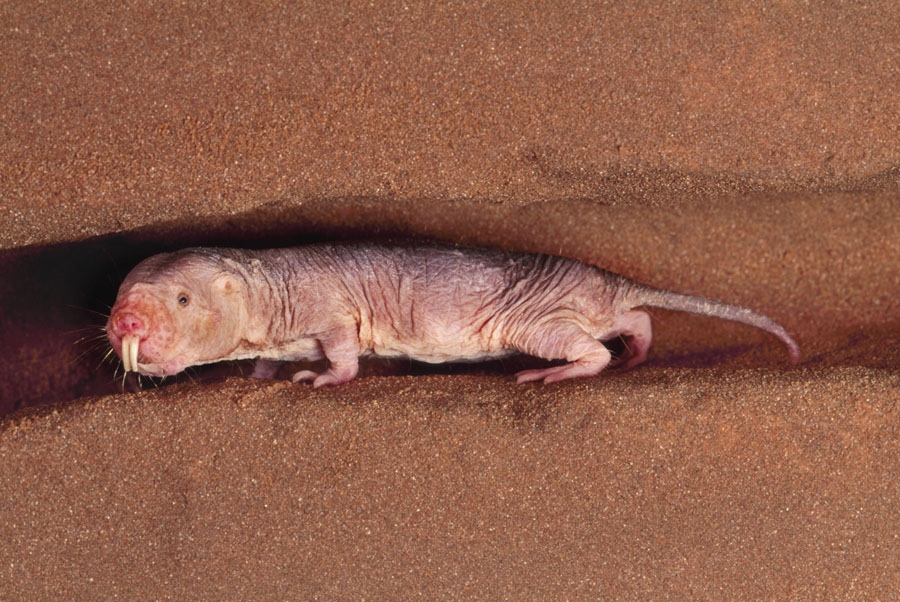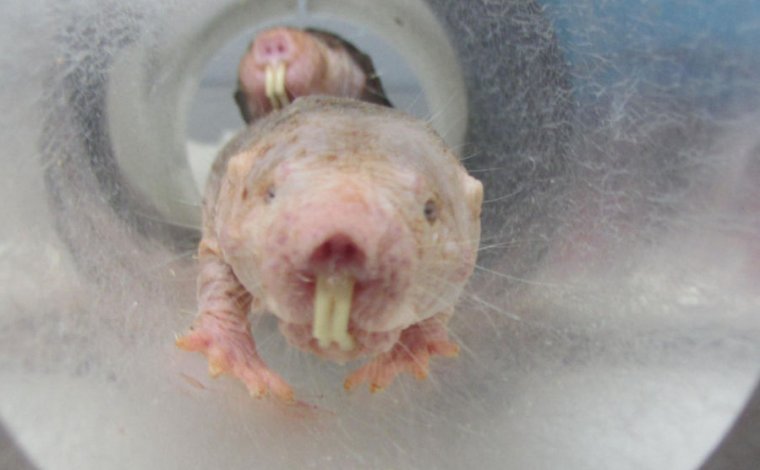Bare Diggers - Superheroes in the Animal World

Under the dry plains of East Africa there are animals that surprise both their appearance and their capabilities. We are talking about naked diggers. Their body is not covered with wool, they have very poor eyesight but good sense of smell, touch and strong paws. These animals can dig long strokes several kilometers long in the ground.
They live in colonies of up to 300 inhabitants. Home in the colony - the queen. This is the only female that reproduces offspring. Rodents born to the world quickly grow up. All their lives (about 30 years), these animals spend in conditions of a small amount of food and water. Naked zemlekopy - small animals with a body length of 8-10 cm, tail - 3-4 cm and weighing 30-35 g. Females are larger: weigh from 50 to 80 g.
The bare excavator lives in the dry savannas and semi-deserts of Kenya, Ethiopia and Somalia. They are secretive burrowing animals, feeding on underground parts of plants, including succulent tubers and bulbs. Food is stored in specially equipped underground storerooms. Bare diggers do not drink water at all and feed almost exclusively on plant tubers. Moisture they get with food.
Apparently, in order to somehow level the life of naked diggers, nature rewarded them with unique abilities. For example, they have almost no cancer. They live much longer than other rodents - 30 years or more. In addition, these animals are insensitive to acid burns and do not feel pain during thermal burns. Even without burns, the rodent does not feel pain when exposed to high temperatures. In addition, excavators are resistant to high concentrations of CO 2 . It is interesting that despite the almost complete absence of the external auditory shell, the animals' hearing is acute, as evidenced by the extensive repertoire of sounds made by excavators.
Scientists have been studying naked diggers for a long time, trying to understand what caused their unique features. Recently in an authoritative editionCell Reports has an article explaining the insensitivity of naked zempkopov to pain. As it turned out, evolutionary changes led to the modification of amino acids in their pain receptors. In addition, experts note the almost complete absence of a “painful neurotransmitter” in adults.
Scientists suggest that bare diggers would hardly have gained their unique abilities if they had not lived in extreme conditions, including social characteristics. Specialists are aware of only two species of animals, whose way of life is so similar to the way of life of social insects - these are naked mole rats and their close relatives are the mole rats.
Females in the colony fight to the death for the right to be a queen, after which they occupy this social position for up to 15 consecutive years. By changing the social status, the animal increases in size, not only due to weight gain, but also due to the increased distance between the vertebrae. After the death of the queen, a death fight begins between the fertile females of the colony, and after the final victory, the victor female becomes the head. Successful colonies can be very large, with an extensive system of moves. Land naked excavators digging with the help of paws and teeth. Despite the fact that the nesting chambers are quite large, there may be many inhabitants there, which probably causes them some inconvenience.
Excavators, like other animals, have a tendency to thermal hyperalgesia. This phenomenon is characteristic of man. Explaining the nature of thermal hyperalgesia is not so difficult. Imagine, for example, sunburned skin on your back. What do you feel if you send warm water to this area? Not hot, but really warm, how we feel the temperature of the water in the normal state. But for the burnt area, this water will seem extremely hot.
The fact is that temperature sensors located in the damaged area are chemically “over-stimulated” as a result of the action of fire, sunlight or any other source of energy. Therefore, even a gentle touch on the burn is perceived by the sensors as a painful sensation. A pain signal is sent to the brain, and the living being feels pain. Everything is logical.
In the case of naked zemplekopov the situation is a little different. When an animal digs in dry ground, the sensors located in the skin are over-excited. But at this time the rodent does not feel pain, as it happens, for example, with a man. And all thanks to special changes in the structure of the amino acids of the skin sensors of the animal. These changes have resulted in the naked digger feeling no pain when exposed to high temperatures. After the injection of a neurotransmitter, known as the “substance P”, the excavators experience pain in full measure.

“We believe that evolutionary changes have led to the fact that the pain sensitivity of rodents has not disappeared altogether, because it represents an undoubted benefit for the animal. But nature has weakened the pain of the diggers to such an extent that they do not give the rodent particular inconvenience. Bare diggers live underground in desert regions, they don’t get so much food. The level of metabolism of excavators is significantly lower than the level of metabolism of any mammal. Under these conditions, evolution has removed that which is not exclusively necessary, ” says Gary Levin, lead author of the study.
Levin and his colleagues also discovered that excavators are born with normal skin sensitivity to heat. But, growing up, they lose this ability. This helps them to save more energy, which is needed in conditions where excavators exist. What is interesting is that small changes in the structure of the amino acids of the organism of the rodent have led to significant consequences.
Now rodents live without constant discomfort, which, undoubtedly, they would have experienced if they had a normal sensitivity to heat. And this is right, because pain is not always necessary for a living organism. In some cases, it only interferes. In the case of bare diggers, pain would be an obstacle to the survival of the entire species. And the evolutionary process has led to the disappearance of the susceptibility of the animal to "heat pain", as such.
DOI: 10.1016 / j.celrep.2016.09.035
